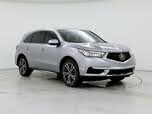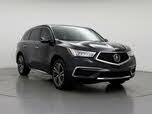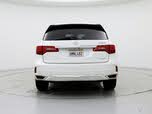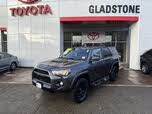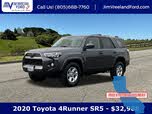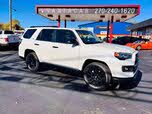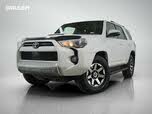2020 Acura MDX vs 2020 Toyota 4Runner
Overview | ||
MSRP | $44,500 | $36,120 |
Average price | $27,123 | $37,309 |
Listings | ||
Ratings & Reviews | ||
User reviews | ||
Expert reviews | 7.2 out of 10Read full review | 6.8 out of 10Read full review |
Pros & cons | Pros
| Pros
|
Summary | The Acura MDX is the best-selling three-row luxury SUV of all time, with solid performances through three generations of production since 2001. While it may not be an industry leader in any one category, the MDX delivers competitive levels of comfort, convenience, and technology and an attractive overall package that has spawned a loyal repeat audience. | Even in its expensive Limited trim, the Toyota 4Runner remains clearly purpose-built for tackling terrain. Whether on a dusty cow path or snowy mountain road, the 4Runner looks most in its element when its outside the typical car’s comfort zone. For 2020, Toyota keeps enough chrome and leather available to market the 4Runner as a rough-and-tumble luxury alternative, but shoppers considering one had better have a real need for 4-wheel drive. |
Video | No video found | No video found |
Popular Features & Specs | ||
Engine | 3.5L 290 hp V6 | 4.0L 270 hp V6 |
Drive Train | FWD | 4X2 |
Seating Capacity | 7 | 7 |
Horsepower | 290 hp @ 6200 rpm | 270 hp @ 5600 rpm |
MPG City | 20 | 16 |
MPG Highway | 27 | 19 |
Engine | ||
Engine Name | 3.5L 290 hp V6 | 4.0L 270 hp V6 |
Torque | 267 lb-ft @ 4700 rpm | 278 lb-ft @ 4400 rpm |
Horsepower | 290 hp @ 6200 rpm | 270 hp @ 5600 rpm |
Drivetrain | FWD | 4X2 |
Fuel Economy | ||
MPG City | 20 | 16 |
MPG Highway | 27 | 19 |
Interior | ||
Seating Capacity | 7 | 7 |
Key Features | ||
Sunroof/Moonroof | Standard | |
Safety | ||
Front Crash Overall | 5 | 4 |
Side Crash Overall | 5 | 5 |
Dimensions & Capacity | ||
Cargo Space | 15.0 cu ft | 47.2 cu ft |
Curb Weight | 4032 lbs | 4400 lbs |
Height | 67.4 in | 71.5 in |
Length | 196.2 in | 190.2 in |
Width | 77.7 in | 75.8 in |
Wheelbase | 111.0 in | 109.8 in |
Maximum Payload | 1336 lbs | 1700 lbs |
Number of doors | 4 | 4 |
Maximum Towing Capacity | 3500 lbs | 5000 lbs |
Standard Towing Capacity | 5000 lbs | |
The 2020 Acura MDX presented an elegant, understated design that didn't strive for groundbreaking or breathtaking but rather for a clean, sophisticated appearance. Its styling didn't attract undue attention in parking lots or garner special treatment from valets. Instead, it blended seamlessly into various settings, which many drivers found perfectly acceptable.
Acura's signature Jewel Eye LED headlights were a standout feature. These LED lights, with five elements per side arranged in a sleek housing, offered both functionality and an upscale look to the MDX's front end. The headlights flanked a trapezoidal grille with a prominent Acura logo at its center, contributing to an expressive front face.
For a three-row SUV, the MDX had a sleek, low-slung profile with chiseled details and a fast roofline. Acura's reputation for flawless paint and chrome finishes was evident in the MDX, maintaining a high level of craftsmanship.
Inside, the MDX's modern and simple interior design eschewed excessive padding and stitching, which had become common in luxury vehicles. The center stack was a highlight, featuring twin infotainment screens: an 8.0-inch LED screen for navigation and an On-Demand Multi-Use Display (ODMD) touchscreen below. The three rows of buttons and a prominent command wheel added to the sophisticated layout.
High-quality materials and meticulous fit and finish gave the MDX a solid and well-built feel. Knobs and switches operated with precision, and the overall tactile experience was rewarding.
In contrast, the 2020 Toyota 4Runner's design remained rooted in utilitarianism. The tall slab sides, high beltline, short overhangs, and near-vertical front fascia contributed to its rugged and timeless look, similar to the classic XJ Jeep Cherokee. The design prioritized function over flash, with flared wheel wells accommodating bulky off-road tires and short overhangs enabling steep pitches and sharp declines.
Small, angular headlights defined the front end, framed by twin body-colored bars on most trims and blacked-out accents on the TRD Pro. The Limited trim featured bright chrome accents, lending a touch of sophistication.
Toyota offered a diverse trim lineup for the 4Runner, including SR5, SR5 Premium, TRD Off-Road, TRD Off-Road Premium, TRD Pro, and Limited. The Nightshade Special Edition and Venture Special Edition trims added unique aesthetics, with blacked-out trim pieces and off-road enhancements like 17-inch TRD wheels and a Yakima Megawarrior roof rack.
Our test model, the Limited trim, leaned more towards comfort than rugged capability. Leather upholstery covered the seats, although lower trims featured cloth, and the SR5 Premium and TRD Off-Road Premium trims used SofTex material. Despite the upscale appointments, the 4Runner Limited still had a utilitarian feel, with significant plastic components and a seating position optimized for off-road exploits.
The 2020 Acura MDX offered two powertrains. The first was a naturally aspirated 3.5-liter V6 engine with direct injection and variable valve timing, generating 290 horsepower and 267 pound-feet of torque. This engine was mated to a nine-speed automatic transmission, with the option of front-wheel or all-wheel drive. The MDX Sport Hybrid featured a 3.0-liter V6 engine and three electric motors, delivering a combined system power of 321 horsepower and 289 pound-feet of torque, coupled with a seven-speed dual-clutch automatic transmission and all-wheel drive.
During our test, we drove the gasoline-only model equipped with Acura's Super-Handling All-Wheel Drive (SH-AWD) system. The MDX impressed with its straight-line performance, offering enthusiastic acceleration and responsive takeoff. Paddle shifters allowed for manual sequential shifting, but the transmission's refined behavior often negated their necessity. The MDX’s SH-AWD system with torque vectoring significantly improved cornering abilities, seamlessly directing power to the outside rear wheel during turns, ensuring stability and smooth corner exits without any drama.
The MDX featured a four-wheel independent suspension system that effectively absorbed road imperfections, providing a comfortable ride for long drives.
In contrast, the 2020 Toyota 4Runner came with a single powertrain option: a 4-liter V6 engine paired with a 5-speed automatic transmission. This engine produced 270 horsepower and 278 pound-feet of torque. It wasn't the most refined or fuel-efficient engine, but it was designed for durability and off-road performance. The 4Runner could tow up to 5,000 pounds, highlighting its rugged capabilities.
The fuel economy of the 4Runner left much to be desired, with EPA estimates of 16 mpg city, 19 highway, and 17 combined. During our test, we achieved a slightly better 17.7 mpg over 400 miles of driving.
The 4Runner performed exceptionally well off-road, thanks to its body-on-frame construction and advanced off-road features like Toyota’s CRAWL control and Multi-Terrain Select. The 4Runner's handling on highways was less refined, with significant body roll and heavy, vague steering. Its high center of gravity and imprecise steering made it a more challenging vehicle to maneuver on paved roads.
Three-row SUVs had become the go-to choice for families, and the Acura MDX was no exception. Its sliding and reclining second-row seats facilitated easy access to the third row, allowing for flexible legroom distribution. Ample headroom was available in all three rows. With the third row in use, the MDX provided 15.8 cubic feet of luggage space. Folding the third row flat expanded the cargo capacity to 43.4 cubic feet, and folding both rear rows down yielded a cavernous 90.9-cubic-foot cargo hold. The load floor was reasonably flat, making it practical for transporting large items. Additional storage options included a recessed cubby hole on the left side of the rear cargo area and a covered underfloor storage space for valuables.
Up front, the MDX featured a spacious glove box, a drop-down sunglass pocket, and a flexible center console with big cupholders and a sliding armrest. The center console also housed USB, power, and auxiliary jacks, with enough space for a tablet or small laptop. Door panels had water-bottle pockets and open storage compartments. Second-row passengers enjoyed cupholders and seat-back pouches, while third-row passengers had an outboard armrest with a storage bin and cup holder. Tri-zone climate control ensured that all occupants could enjoy personalized heating and cooling settings.
The 2020 Toyota 4Runner had a distinct focus on visibility and off-road functionality. Despite its generous dimensions, drivers had no trouble keeping track of the 4Runner’s position on the road. Its 18-foot, 7-inch turning radius was surprisingly tight, outclassing competitors like the Toyota Highlander and Jeep Wrangler Unlimited.
The interior of the 4Runner was designed with rugged use in mind. Large, chunky knobs controlled the HVAC system, while slightly smaller knobs handled stereo volume and tuning. The 8-inch touchscreen was flanked by physical buttons for easy navigation. Steering-wheel controls managed various functions, but their lack of illumination made them difficult to use in low light.
Due to its body-on-frame construction and impressive ground clearance, the 4Runner had a tall seating position. Power-retractable running boards aided entry and exit, especially for shorter owners. Once inside, the commanding view and sense of insulation from road imperfections were notable.
The 4Runner offered an optional third row in non-TRD and non-Venture trims, but these seats were best suited for short-term use. Unlike the spacious benches in some competitors, the 4Runner’s third row consisted of narrow, thin jump seats, which compromised comfort.
The 4Runner's cargo capacity was practical for its intended use. Without the third row, the cargo area offered significant space, though exact measurements weren’t provided. The vehicle was designed to accommodate outdoor gear and rugged adventures rather than maximizing passenger and cargo versatility like the MDX.
Acura simplified its trim levels into packages, packing most tech features into these bundles. The base MDX came well-equipped with standard features including Siri Eyes Free, Apple CarPlay, Android Auto, hands-free Bluetooth, SMS/MMS text messaging, a CD/MP3 player, five USB ports, SiriusXM satellite radio, and an eight-speaker audio system. However, it lacked some cutting-edge tech seen in competitors.
Upgrading to the Technology Package added rain-sensing windshield wipers, LED puddle lights, front and rear parking sensors, navigation with Acura Real-Time Traffic, GPS-linked climate control, remote engine start, and a 10-speaker Acura/ELS Studio Premium Audio system. The Advance Package further enhanced the tech offerings with an Active Damper System suspension, LED fog lights, heated and ventilated front seats, power lumbar support, heated rear outboard seats, a surround-view camera system, Head-Up Warning, and additional USB ports for third-row passengers.
The Entertainment Package, available for $2,000, added a rear-seat DVD entertainment system with a 110-volt power outlet and wireless headphones. The Advance Package featured a 16.2-inch Ultra-Wide Full VGA screen with HDMI compatibility and two additional speakers, while the Technology Package offered a 9.0-inch Full VGA screen with one additional speaker.
The 2020 Toyota 4Runner had lagged in technology for years, but for 2020, Toyota addressed some of these shortcomings. The 4Runner now included an 8-inch touchscreen infotainment system with Apple CarPlay and Android Auto compatibility, making it easier to use smartphones with the SUV. The inclusion of modern projection systems like CarPlay and Android Auto was a significant improvement, given that factory systems often lagged in usability.
Toyota's proprietary infotainment system was not overly complex, but managing the onboard navigation proved challenging. When we input our destination using the system, it estimated a much longer drive time compared to Google Maps via Android Auto. This discrepancy highlighted the superiority of smartphone-based navigation.
The 4Runner also offered Amazon Alexa compatibility, Bluetooth connectivity, a single USB media port in SR5 and TRD Off-Road trims, along with subscription services like SiriusXM Radio, Safety Connect, and WiFi Connect. Higher trims featured a JBL stereo system and the navigation system.
Despite these updates, the 4Runner still lagged behind competitors regarding overall tech features and usability. Its 8-inch touchscreen was a welcome upgrade, but many competitors offered larger, brighter screens with more advanced features.
The 4Runner's technological strengths were more focused on off-road performance. Features like Toyota's CRAWL control and Multi-Terrain Select were advanced systems designed to aid off-road driving, providing significant benefits when traversing rugged landscapes.
The 2020 Acura MDX came standard with AcuraWatch, a suite of passive and active safety features, and advanced driver assistance systems. This suite included adaptive cruise control with low-speed follow, lane-keeping assist, forward-collision warning, lane-departure warning, and automatic emergency braking.
The Technology Package added blind-spot monitoring with rear cross-traffic alert, while the Advance Package included Head-Up Warning. Additional safety equipment included a rearview camera with dynamic guidelines, which upgraded to a surround-view camera in the Advance Package. The MDX also featured front airbags, front-side airbags, side curtain airbags with a rollover sensor, a driver’s knee airbag, stability control with traction control and motion-adaptive steering, Trailer Stability Assist on all-wheel-drive models, tire pressure monitoring with location and pressure indicators, LATCH child-seat mounts, and a theft-deterrent system with an electronic immobilizer.
Acura’s Next-Generation Advanced Compatibility Engineering (ACE) Body Structure was designed to absorb crash impact, transferring energy away from occupants to enhance safety.
The Insurance Institute for Highway Safety (IIHS) rated the MDX as “good” in all crash-test categories, “acceptable” for headlights, “superior” for front crash prevention, and “acceptable” for LATCH ease of use. The National Highway Traffic Safety Administration (NHTSA) awarded the MDX a five-star overall safety rating.
Toyota also updated the 2020 4Runner with modern safety technologies. The 4Runner now featured Toyota Safety Sense P (TSS-P), a suite of advanced driver assistance systems (ADAS). TSS-P included adaptive cruise control, lane-departure alert, a pre-collision system with pedestrian detection, and automatic high beams.
The 2020 4Runner came equipped with eight standard airbags, significantly enhancing safety compared to previous models. This made the 4Runner a safer vehicle overall, relying less on its size and more on modern technology.
The NHTSA awarded the 4Runner four out of five stars overall, but it scored only three out of five in the rollover test. Similarly, the IIHS rated the 4Runner as “Good” in most crash tests, except the small overlap front: driver-side test, where it scored “Marginal.”
During highway driving, we found the adaptive cruise control effective, though the 4Runner’s high center of gravity and imprecise steering called for a more active lane-keeping assist system rather than the reactive lane-departure alert it featured.
CarGurus highlights
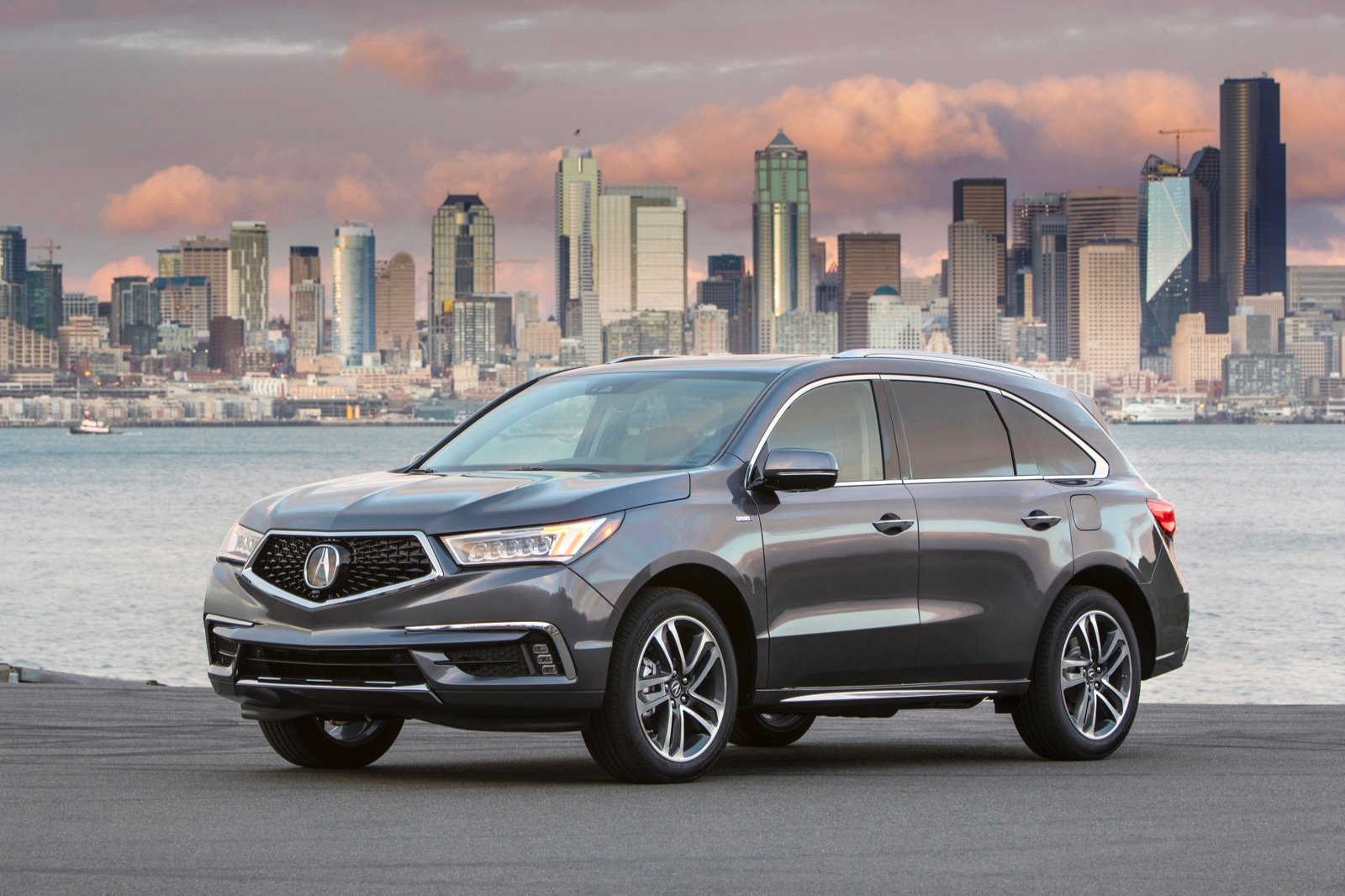
According to CarGurus experts, the overall rating for the 2020 Acura MDX was 7.2 out of 10, while the 2020 Toyota 4Runner scored 6.8 out of 10. Both vehicles had their unique strengths and catered to different consumer needs. However, based on these ratings, the 2020 Acura MDX emerged as the better choice for those seeking a well-rounded, family-friendly SUV with advanced safety features, refined performance, and versatile interior space. The 2020 Toyota 4Runner excelled in off-road capability and durability but lagged in fuel efficiency and overall technological advancements. For a more modern and luxurious driving experience, the Acura MDX took the lead.
Choose the 2020 Acura MDX if:
Shop Now- You value a refined, comfortable ride with sophisticated handling and advanced torque-vectoring all-wheel drive.
- You need versatile cargo and passenger space with practical storage solutions and flexible seating arrangements.
- You prefer a modern, tech-savvy interior with advanced safety features and a comprehensive suite of driver assistance systems.
Choose the 2020 Toyota 4Runner if:
Shop Now- You need a rugged, off-road capable SUV with advanced off-road features like CRAWL control and Multi-Terrain Select.
- You prefer a vehicle with a long-standing reputation for durability and reliability, even if it means sacrificing fuel efficiency.
- You appreciate a tall seating position with commanding visibility and a body-on-frame construction designed to withstand harsh terrains.

By: CarGurus + AI
At CarGurus, our team of experienced automotive writers remain at the heart of our content operation, conducting hands-on car tests and writing insightful guides that are backed by years of industry experience. To complement this, we are harnessing AI to make our content offering more diverse and more helpful to shoppers than ever. To achieve this, our AI systems are based exclusively on CarGurus content, ratings and data, so that what we produce is both unique to CarGurus, and uniquely helpful to car shoppers.
























